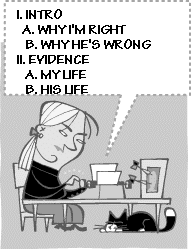
 |
An outline is: |
An outline reflects logical thinking and correct classification.
Generally
Particularly
Before you begin:
Then:
| List all the ideas you want to include in this writing. |  |
An outline has a balanced structure which uses the principles of:
Whenever possible, in writing an outline, coordinate heads should be expressed in parallel form. That is, nouns should be made parallel with nouns, verb forms with verb forms, adjectives with adjectives, and so on. Although parallel structure is desired, logical and clear writing should not be sacrificed simply to maintain parallelism (For example, there are times when nouns and gerunds used at the same level of an outline are acceptable.) Reasonableness and flexibility of form is preferred to rigidity.
In outlining, those items which are of equal significance have comparable numeral or letter designations; an A is equal a B, a 1 to a 2, an a to a b, etc. Coordinates should be seen as "having the same value." Coordination is a principle that enables the writer to maintain a coherent and consistent document.
Explanation: Adorno and Horkheimer represent one example of producer led theories of consumption and should be treated as a subdivision. Baudrillard represents an example of consumer led theories of consumption. One way to correct coordination would be:
In order to indicate relevance, that is levels of significance, an outline uses major and minor heading. Thus in ordering ideas you should organize material from general to specific or from abstract to concrete - the more general or abstract the concept, the higher the level or rank in the outline. This principle allows your material to be ordered in terms of logic and requires a clear articulation of the relationship between component parts used in the outline. Subdivisions of a major division should always have the same relationship to the whole.
Explanation: There is an A without a B. Also 1, 2, 3 are not equal; Applewriter is a type of word processing program, and useful and obsolete are qualities. One way to correct this faulty subordination is:
To divide you always need at least two parts; therefore, there can never be an A without a B, a 1 without a 2, an a without a b, etc. Usually there is more than one way to divide parts; however, when dividing use only one basis of division at each rank and make the basis of division as sharp as possible.
FORM
The most important rule for outlining form is to be consistent!!
An outline can use TOPIC OR SENTENCE STRUCTURE.
A TOPIC outline uses words or phrases for all entries; uses no punctuation after entries
Advantages - presents a brief overview of work; is generally easier and faster to write than a sentence outline
A SENTENCE outline uses complete sentences for all entries; uses correct punctuation
Advantages - presents a more detailed overview of work including possible topic sentences; is easier and faster for writing the final paper.
An outline can use Roman Numerals/Letters or Decimal form.
Roman Numeral Decimal I. 1.0 A. 1.1 B. 1.2 1. 1.2.1 2. 1.2.2 a. 1.2.2.1 b. 1.2.2.2
II. 2.0 A. 2.1 B. 2.2 C. 2.3